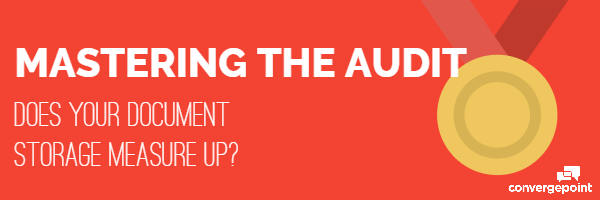Mastering the Audit: Does Your Document Storage Measure Up?

On January 8, 2013, the American Action Forum published a study outlining that the total regulatory burden placed on the U.S. economy in 2013 by governmental regulators amounted to $112 billion.
OIRA, The Office of Information and Regulatory Affairs, then translated this number into the number of hours U.S. workers spent processing the regulatory paperwork, 157 million hours. The large regulatory burden on U.S. workers is not surprising, as most industries have seen increased regulatory compliance under the Obama administration. Increased regulations translate to increased scrutiny in compliance measures, making audits even more powerful tools for organizations.
As soon as the word audit is mentioned, however, a sense of anxiety and negativity can often overcome receivers. Why do audits typically produce such negative imagery? One word comes to mind: exposure. The whole purpose of an audit is to protect your future interests by assessing key areas of improvement within your organization. It’s peeling back the layers of your organization to identify risks and analyze efficiency; it’s taking a moment to stare at your faults head on and take corrective action. Why should it be such a negative experience?

How Can You Ensure a Successful Audit?
By following a few key considerations such as creating a paperless system and designing a versioning process, organizations can take the stress out of the process and streamline their data management. To begin, an organization must consider where it is currently storing its regulatory documents and in what format. Previously, the status quo for document storage was a large physical storage facility, usually offsite, which held 10+ years of records. Organizations had records administrators who were in charge of indexing the paperwork, creating a system for document requests, and then physically pulling the records upon request. The physical nature of document management led to issues like documents that would be pulled and never returned, and information that would go missing or be accidentally destroyed without a secondary backup. Companies were paying top dollar for non-value creating buildings, employees, and materials that were highly inefficient.
Technological advances then started moving companies from costly paper systems to paperless systems, but this status quo led to companies sharing documents over shared drives, email systems, and intranets. The problems of physical storage may have been addressed, but these solutions created new concerns with collaboration, version histories, and sensitive data storage. Documents were present and searchable, but they were often unclear in which document was the most current version, which employee had the document, or what changes were being made. Policies and procedures were distributed to employees over emails, and there was no accountability to ensure that the employees did in fact read the material or agree to abide by the material unless they signed a paper document. This led to companies using paper documents to keep track of paperless policies, and admins had to physically track compliance measures. Document management was somewhat more streamlined, but the auditing process was still a nightmare.
Increases in regulation and compliance concerns have led to the next evolutionary step in document processing and management. Companies are starting to realize the metadata associated to their documents is becoming just as important as the documents themselves. We have seen and been a part of the huge shift to central document repositories and streamlined requests processes that provide access to metadata, version histories, and a place for document discussions. These central repositories have made it simple to tell when documents are missing, what is the latest version, and who was a part of each step of the creation process.
ConvergePoint Exercises Best Practices in Document and Process Management
ConvergePoint began on the premise that the current solutions for document management were labor-intensive and inefficient; we wanted to simplify the process. We offer four products that expand on your existing SharePoint 2010 or 2013 platform and use your active directories and document library to organize document processes and storage. For example, our Contracts Management System streamlines the request process and creates an active distribution site for all active contracts. It keeps a version history with a comments board so you can see exactly how a contract evolved during its creation process, and protect yourself in the case of legal proceedings.
Our Policy Management System streamlines the creation and approval process of policies and procedures, provides automatic distribution to your employees, and provides a way to certify that your employees agreed to abide by the policy. We’ve taken these labor intensive processes out of the IT department, streamlined their application, and put them in the control of the departments that are actually creating the documentation. Our clients have seen a generous ROI in terms of document auditing transparency, reduced labor and paper costs, and letting IT focus on what they do best.
Reference: A Regulatory Flurry: The Year In Regulation, 2013 by The American Action Forum
Reference: Daily Tally by The Office of Information and Regulatory Affairs (OIRA)
Image courtesy of Stuart Miles at FreeDigitalPhotos.net
Download Policy Management WhitePaper
How To Establish Contact Management System At Your Organization
Download free guideAchieving Efficient Contract Management At Your Organization
Get the whitepaperIndustries served
Manufacturing and Retail Industry
Many manufacturing and retail companies have a decentralized business model with
Healthcare
The healthcare industry encompasses a wide range of facilities from hospital
Financial Services and Banking
Every organization in the financial service industry — whether a commercial bank,
Insurance and Employee Benefits
The insurance and employee benefits industry knows more than anyone else
Energy and Utilities
Navigating the increasingly complex regulatory requirements can be tough for
Transportation
Abide by FAA, DOT, FMCSA, FRA and FTA regulations, educate drivers and third party vendors on guidelines, and streamline overall compliance.
